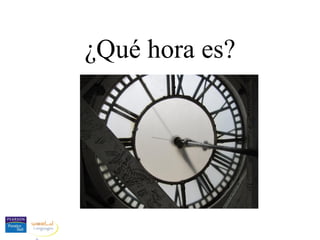
QuéHoraEs
- 2. When we ask what time it is in Spanish, we say “¿Qué hora es?”
- 3. ¿Qué hora es? The third-person singular of ser is used with one o’clock since it is just one hour (hora). 11 12 1 Es la una. 10 2 9 3 The singular definite article is used for the same reason. 8 4 7 5 6 All hours of the day are feminine in Spanish.
- 4. ¿Qué hora es? The third-person plural of ser is used with all hours after one o’clock. 11 12 1 Son las dos. 10 2 9 3 Likewise, the plural definite article is used for all hours 8 4 after one o’clock. 7 5 6
- 5. ¿Qué hora es? 11 12 1 Son las tres. 10 2 (etc.) 9 3 8 4 The formula for all hours after 7 5 one is Son las + the hour. 6
- 6. ¿Qué hora es? Es la una y 11 12 1 10 2 diez. 9 3 To express minutes after the 8 4 hour, we simply add y and the 7 5 number of minutes. 6
- 7. ¿Qué hora es? Son las tres y quince. 11 12 1 or . . . 10 2 9 3 Son las tres y cuarto. 8 7 5 4 6 Cuarto is a masculine noun that means a quarter (of an hour).
- 8. ¿Qué hora es? Son las cuatro y media. 11 12 1 10 2 or . . . 9 3 Son las cuatro y 8 5 4 treinta. 7 6 Medio/a is an adjective that means half. It is used in the feminine singular when telling time, since it modifies the unexpressed noun hora.
- 9. ¿Qué hora es? Son las cinco y cuarenta. 11 12 1 10 or . . . 2 9 3 Son las seis 8 4 menos veinte. 7 6 5 After the halfway point of a given hour, Spanish gives us the option of stating the next hour minus (menos) a number of minutes.
- 10. ¿Qué hora es? Son las siete y cuarenta y cinco. or . . . Son las ocho menos cuarto. (quince)
- 11. ¿Qué hora es? Son las siete 11 12 1 en punto. 10 2 9 3 En punto literally means “on the dot,” and is used to stress 8 4 that an exact hour is being 7 6 5 expressed, with no minutes before or after.
- 12. ¿Qué hora es? Son las nueve menos cinco. 11 12 1 10 2 or . . . 9 3 Son las ocho y 8 4 cincuenta y 7 6 5 cinco.
- 13. ¿Qué hora es? Son las doce or . . . Es medianoche. Note: Some Spanish speakers say “Son las doce de la noche”.
- 14. ¿Qué hora es? Son las doce or . . . Es mediodía. Note: Some Spanish speakers say “Son las doce de la tarde”.
- 15. ¿Qué hora es? (A.M.) Son las cinco y 11 12 1 cuarto de la 10 2 mañana. 9 3 8 4 Notice that in Spanish we say “of 7 6 5 the morning” rather than “in the morning.”
- 16. Expressing P.M. time ¿Qué hora es? 11 12 1 10 Son las dos 2 de la tarde. 9 3 8 4 7 5 6 Tarde is used for afternoon and evening hours. Notice that, again, we say “of the afternoon.”
- 17. ¿Qué hora es? (P.M. ) Son las nueve 11 12 1 de la noche. 10 2 9 3 8 4 Normally, after sundown we begin 5 to say de la noche; however, this 7 6 is somewhat variable, as it is in English. Some feel that 7:00 is a good dividing line.
- 18. Un poco de práctica ¿Qué hora es? 1. 11 12 1 2. 11 12 1 10 2 A.M. 10 2 9 3 9 3 8 4 8 4 7 5 7 5 6 6 11 12 1 10 3. 2 9 3 (On the dot) 8 4 7 5 6
- 19. Un poco de práctica ¿Qué hora es? 4. 11 12 1 5. 11 12 1 10 2 P.M 10 2 9 3 9 3 8 4 . 8 4 7 5 7 5 6 6 11 12 1 10 6. 2 9 3 8 4 7 5 6
- 20. ¿A qué hora es . . . ? When we talk about the time at which an event begins, we must say “At what time (hour) is . . . ?” To answer, we must say “Es a la una,” or “Es a las dos,” etc. ¿A qué hora es la clase de español?
- 21. FIN